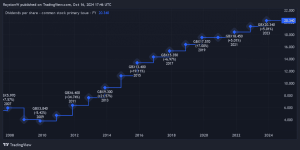With only so many hours in a day, passively earning a second income is an attractive proposition. And as it turns out, it doesn’t even take that much capital. Investing just £200 a month – more than half the average household savings rate – is enough to boost an annual income.
Leveraging dividends
If earning a second income’s the objective, dividend stocks are likely the best place to start hunting investment opportunities. These businesses are typically much larger and more established. And that can come with some powerful advantages like lower volatility and greater resilience to stock market wobbles.
These mature enterprises often don’t offer much in terms of growth, especially compared to some explosive companies in the tech sector. Yet this shortfall can be more than made up through lucrative and reliable dividends.
When a company generates more cash than it knows what to do with, this money can be returned to shareholders via a dividend. In other words, investors can earn a second income just by buying and holding shares in dividend-paying companies.
On average, British dividend-paying companies offer a yield of around 4%. So for every £200 invested, that’s £8 in passive income. On the surface, it certainly doesn’t seem like a lot. But when left to compound over a few years, that can change drastically.
Earning £2,000
When combined with share price appreciation, investors can expect to earn a total return of around 8% a year with UK large-cap stocks. At least, that’s what the historical performance of the FTSE 100 shows. And investing £200 a month at this rate for 12 years would build a portfolio worth just shy of £50,000, capable of generating a £2,000 second income.
That’s not bad, but waiting 12 years is hardly ideal. So how can investors accelerate this journey? The easiest way is to just invest more money each month. Putting aside £300 instead of £200 would chop off just shy of three years from the waiting time.
However, not everyone’s fortunate enough to do this. Instead, investors can aim to boost their annual returns by investing in individual businesses. This requires a more hands-on approach to the stock market and comes with higher risk. But it also opens the door to market-beating returns, as investors in Auto Trader (LSE:AUTO) have discovered.
Since going public in 2015, the online vehicle marketplace has risen to sector dominance. It’s now one of the most widely visited sites by car buyers. So it’s no surprise the share price has climbed 220% over this period, translating into an annualised return of 13.9% — of course, that strong return isn’t guaranteed going forward.
Despite its industry-leading status, the firm continues to impress with the latest results, delivering double-digit sales growth and expanding profit margins. With the bulk of its business originating from secondhand vehicles, there’s some long-term concern about how this market will be fair once electric vehicles (EVs) rise to dominance. And it’s a risk factor that investors now have to consider.
Regardless, investing £200 a month in a portfolio yielding 13.9% each year would earn a £2,000 second income in less than eight years.
This post was originally published on Motley Fool







